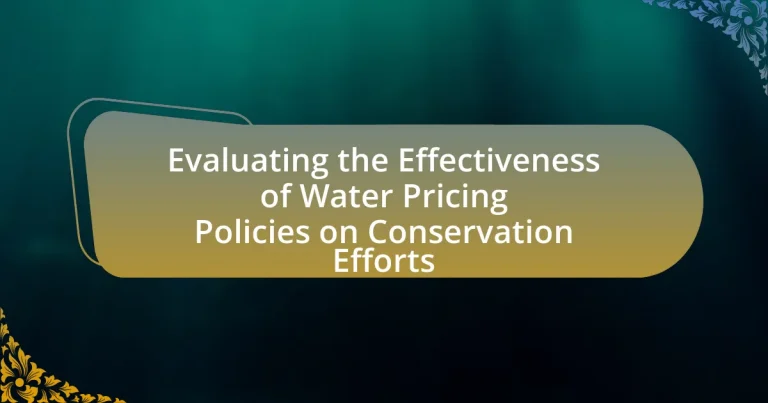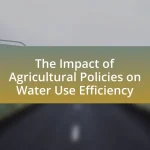Water pricing policies are regulatory frameworks designed to establish the cost of water usage, promoting efficient consumption and conservation. This article evaluates the effectiveness of these policies in achieving conservation goals, highlighting how different pricing structures, such as tiered and seasonal pricing, influence consumer behavior and reduce water consumption. Key factors determining the success of these policies include price elasticity of demand, public awareness, and the overall structure of pricing systems. Additionally, the article discusses the challenges policymakers face, the role of economic incentives, and best practices for enhancing the effectiveness of water pricing strategies in sustainable water management.
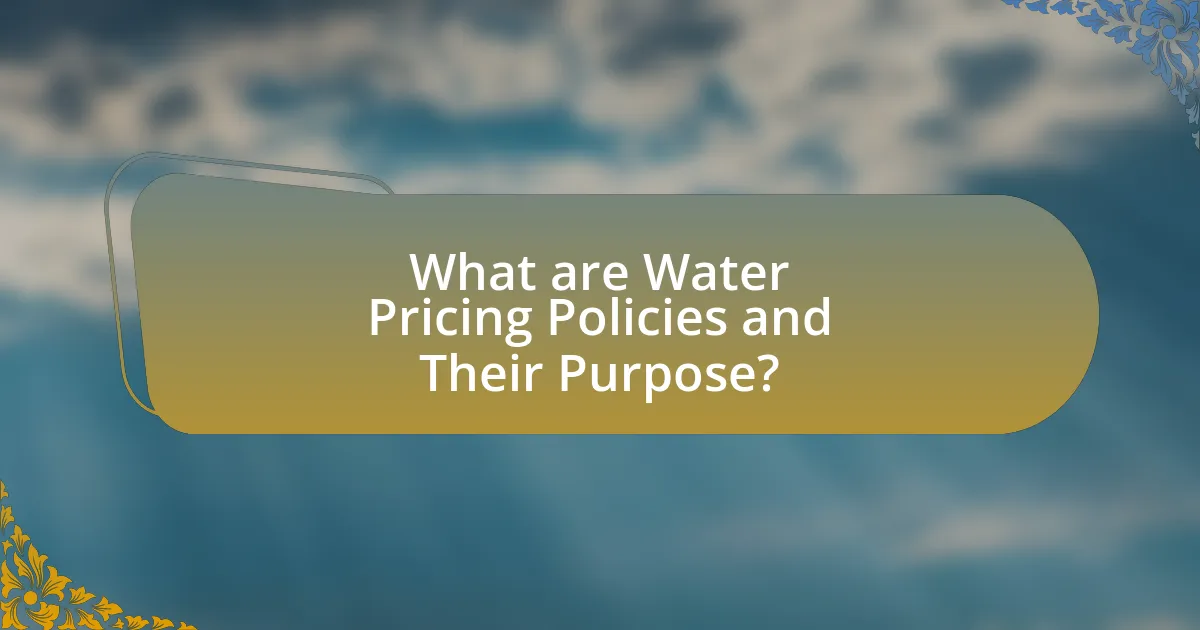
What are Water Pricing Policies and Their Purpose?
Water pricing policies are regulatory frameworks that establish the cost of water usage to promote efficient consumption and conservation. These policies aim to reflect the true economic value of water, encouraging users to reduce waste and manage resources sustainably. For instance, tiered pricing structures charge higher rates for increased usage, incentivizing conservation behaviors among consumers. Studies have shown that effective water pricing can lead to significant reductions in water consumption; for example, a report by the World Bank indicated that cities implementing such policies saw a decrease in water use by up to 30%.
How do water pricing policies influence consumer behavior?
Water pricing policies significantly influence consumer behavior by altering the cost of water usage, which in turn affects consumption patterns. When prices increase, consumers tend to reduce their water usage, adopt conservation practices, and invest in water-efficient technologies. For instance, a study by the American Water Works Association found that a 10% increase in water prices can lead to a 3-5% reduction in residential water consumption. This demonstrates that higher pricing effectively incentivizes consumers to be more mindful of their water usage, thereby promoting conservation efforts.
What factors determine the effectiveness of these policies?
The effectiveness of water pricing policies on conservation efforts is determined by several key factors, including price elasticity of demand, public awareness, and the structure of the pricing system. Price elasticity of demand measures how sensitive consumers are to changes in water prices; higher elasticity indicates that consumers will reduce usage significantly when prices rise. Public awareness campaigns can enhance the effectiveness of pricing policies by informing consumers about the importance of conservation and the impact of their water usage. Additionally, the structure of the pricing system, such as tiered pricing that charges higher rates for excessive use, can incentivize conservation by making it more costly to waste water. These factors collectively influence how well water pricing policies achieve their conservation goals.
How do different pricing structures impact water usage?
Different pricing structures significantly impact water usage by influencing consumer behavior and conservation efforts. For instance, tiered pricing, where the cost per unit increases with higher consumption, encourages users to reduce their water usage to avoid higher rates. Research conducted by the American Water Works Association found that communities implementing tiered pricing saw a reduction in water consumption by 10-20% compared to those with flat rates. Additionally, time-of-use pricing, which charges more during peak demand periods, further incentivizes users to conserve water during high-demand times, leading to more efficient overall usage. These pricing strategies demonstrate a direct correlation between cost structures and water conservation behaviors among consumers.
Why are water pricing policies essential for conservation efforts?
Water pricing policies are essential for conservation efforts because they create economic incentives for efficient water use and promote sustainable consumption. By assigning a cost to water, these policies encourage individuals and businesses to reduce waste and adopt conservation practices. For instance, studies have shown that areas implementing tiered pricing structures, where higher usage leads to significantly increased rates, have experienced reductions in water consumption by up to 30%. This demonstrates that when users face higher costs for excessive use, they are more likely to conserve water, thereby supporting overall conservation goals.
What role do economic incentives play in water conservation?
Economic incentives play a crucial role in water conservation by encouraging individuals and businesses to reduce water usage through financial benefits. For instance, tiered pricing structures, where the cost of water increases with higher usage, motivate consumers to conserve water to avoid higher bills. Research indicates that regions implementing such pricing policies have seen significant reductions in water consumption; for example, a study by the American Water Works Association found that cities with tiered pricing reduced water use by 10-30%. These economic incentives effectively align the cost of water with its scarcity, promoting sustainable usage practices.
How do pricing policies align with sustainable water management goals?
Pricing policies align with sustainable water management goals by incentivizing conservation and promoting efficient water use. These policies, such as tiered pricing structures, charge higher rates for excessive consumption, thereby encouraging users to reduce wasteful practices. Research indicates that regions implementing such pricing strategies have seen significant reductions in water usage; for example, a study by the American Water Works Association found that communities with tiered pricing reduced consumption by up to 20%. This alignment not only conserves water resources but also supports the long-term sustainability of water supply systems, ensuring that future generations have access to clean water.
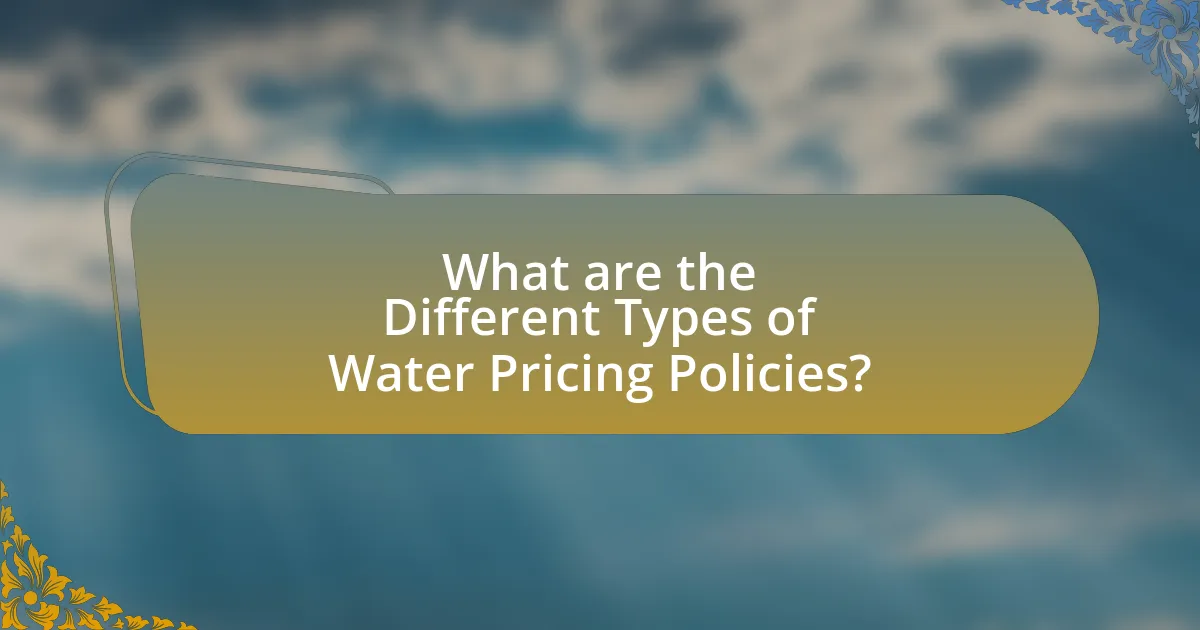
What are the Different Types of Water Pricing Policies?
The different types of water pricing policies include flat rate pricing, increasing block pricing, decreasing block pricing, and seasonal pricing. Flat rate pricing charges a fixed fee regardless of consumption, which can lead to overuse. Increasing block pricing sets higher rates for higher consumption levels, incentivizing conservation by making excessive use more expensive. Decreasing block pricing offers lower rates for higher consumption, which may encourage increased use. Seasonal pricing adjusts rates based on demand fluctuations throughout the year, promoting conservation during peak usage times. These policies are designed to influence consumer behavior and promote efficient water use, as evidenced by studies showing that increasing block pricing can lead to significant reductions in water consumption.
How do flat-rate pricing and tiered pricing differ?
Flat-rate pricing charges a single fixed fee for water usage, regardless of the amount consumed, while tiered pricing sets different rates based on varying levels of consumption. Flat-rate pricing simplifies billing and can lead to higher water usage, as consumers may not feel the financial impact of excessive use. In contrast, tiered pricing incentivizes conservation by increasing costs as consumption rises, encouraging users to limit their water usage to avoid higher charges. Studies have shown that tiered pricing can effectively reduce water consumption, making it a more sustainable option for promoting conservation efforts.
What are the advantages and disadvantages of flat-rate pricing?
Flat-rate pricing offers the advantage of simplicity and predictability for consumers, as it allows them to know their costs upfront without worrying about variable usage. This pricing model can encourage water conservation by incentivizing users to limit their consumption to avoid higher costs associated with tiered pricing structures. However, the disadvantage of flat-rate pricing is that it may lead to overconsumption, as users do not face direct financial consequences for higher usage, potentially undermining conservation efforts. Studies have shown that regions employing tiered pricing models often see more significant reductions in water usage compared to those using flat-rate pricing, highlighting the potential drawbacks of this approach in promoting sustainable water consumption.
How does tiered pricing encourage conservation among users?
Tiered pricing encourages conservation among users by charging higher rates for increased usage, which incentivizes users to reduce their consumption. This pricing structure creates a financial disincentive for excessive water use, prompting individuals and businesses to adopt more efficient practices. Research indicates that tiered pricing can lead to a reduction in water consumption by as much as 15-30%, as users become more aware of their usage levels and the associated costs. For example, a study by the American Water Works Association found that municipalities implementing tiered pricing saw significant decreases in water demand, demonstrating the effectiveness of this policy in promoting conservation efforts.
What is the role of seasonal pricing in water conservation?
Seasonal pricing plays a crucial role in water conservation by incentivizing users to reduce consumption during peak demand periods. This pricing strategy typically involves higher rates for water usage during dry seasons or peak usage times, which encourages consumers to conserve water when it is most scarce. Research indicates that areas implementing seasonal pricing have seen reductions in water usage by as much as 20% during peak months, demonstrating its effectiveness in promoting conservation efforts. By aligning costs with availability, seasonal pricing not only helps manage water resources more sustainably but also fosters a culture of conservation among consumers.
How does seasonal pricing affect water consumption patterns?
Seasonal pricing significantly influences water consumption patterns by incentivizing users to reduce usage during peak demand periods. Research indicates that when water prices increase during high-demand seasons, consumers tend to adjust their consumption behaviors, often leading to a decrease in overall water usage. For example, a study conducted by the American Water Works Association found that implementing seasonal pricing can reduce peak water demand by up to 20%. This reduction occurs as households become more conscious of their water usage, opting for conservation measures such as limiting irrigation and using water-efficient appliances.
What challenges are associated with implementing seasonal pricing?
Implementing seasonal pricing presents several challenges, including customer resistance, complexity in pricing structures, and potential revenue fluctuations. Customer resistance arises as consumers may perceive seasonal pricing as unfair or confusing, leading to dissatisfaction and potential loss of clientele. The complexity in pricing structures can create difficulties in communication and understanding, making it hard for customers to grasp the rationale behind price changes. Additionally, revenue fluctuations can occur due to varying demand across seasons, which may complicate financial forecasting and budgeting for organizations. These challenges necessitate careful planning and clear communication strategies to ensure successful implementation of seasonal pricing.
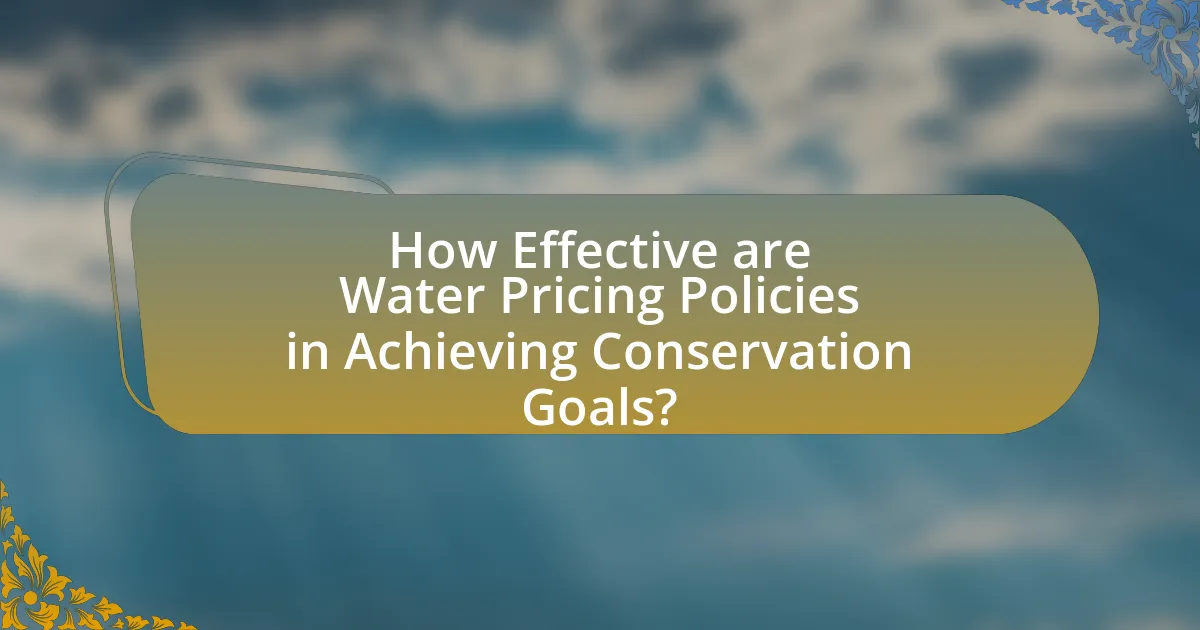
How Effective are Water Pricing Policies in Achieving Conservation Goals?
Water pricing policies are highly effective in achieving conservation goals by incentivizing reduced consumption and promoting efficient water use. Studies have shown that when water prices increase, households and industries tend to decrease their water usage significantly. For instance, a report by the World Bank indicated that a 10% increase in water prices can lead to a 5-15% reduction in consumption, demonstrating a clear correlation between pricing and conservation behavior. Additionally, regions implementing tiered pricing structures, where higher usage incurs steeper rates, have successfully reduced overall water demand while encouraging sustainable practices.
What evidence exists to support the effectiveness of water pricing policies?
Water pricing policies have been shown to effectively promote conservation and efficient water use. Studies indicate that increasing water prices leads to reduced consumption; for instance, a study by the World Bank found that a 10% increase in water prices can result in a 3-7% decrease in water usage. Additionally, research published in the journal “Water Resources Research” demonstrated that tiered pricing structures, which charge higher rates for higher usage, significantly incentivize users to conserve water. These findings underscore the role of pricing as a critical tool in managing water resources and encouraging sustainable practices.
How have specific case studies demonstrated success in conservation?
Specific case studies have demonstrated success in conservation through the implementation of effective water pricing policies that incentivize sustainable usage. For instance, in California, the introduction of tiered water pricing led to a 20% reduction in urban water consumption during drought periods, showcasing how economic incentives can drive conservation behavior. Additionally, in Australia, the Murray-Darling Basin Plan, which included water trading and pricing mechanisms, resulted in improved water efficiency and ecological restoration, with over 1,000 gigaliters of water returned to the environment. These examples illustrate that well-structured pricing policies can significantly enhance conservation efforts by aligning economic interests with environmental sustainability.
What metrics are used to evaluate the success of these policies?
Metrics used to evaluate the success of water pricing policies on conservation efforts include water consumption reduction, cost-effectiveness, and user compliance rates. Water consumption reduction measures the decrease in water usage following the implementation of pricing policies, indicating the effectiveness of these policies in promoting conservation. Cost-effectiveness assesses the economic impact of the policies by comparing the costs incurred to the savings achieved through reduced water usage. User compliance rates reflect the percentage of consumers adhering to the pricing structure, which can indicate public acceptance and the overall success of the policy in changing behavior. These metrics provide a comprehensive framework for assessing the impact of water pricing policies on conservation efforts.
What challenges do policymakers face in implementing effective pricing strategies?
Policymakers face significant challenges in implementing effective pricing strategies for water conservation, primarily due to public resistance and the complexity of accurately assessing water value. Public resistance often stems from concerns about affordability and equity, as higher prices can disproportionately affect low-income households. Additionally, the complexity of determining the true value of water involves accounting for various factors, such as environmental impacts and social equity, which complicates the pricing structure. For instance, a study by the World Bank highlights that effective water pricing must balance economic efficiency with social equity to gain public acceptance, illustrating the multifaceted nature of this challenge.
How do socio-economic factors influence the acceptance of pricing policies?
Socio-economic factors significantly influence the acceptance of pricing policies by shaping individuals’ perceptions of fairness, affordability, and value. For instance, higher-income households may be more willing to accept increased water pricing if they perceive it as a means to promote conservation and sustainability, while lower-income households may resist such policies due to concerns about financial strain. Research indicates that communities with higher levels of education and income are more likely to support environmental pricing policies, as they often have greater awareness of the long-term benefits associated with conservation efforts. Additionally, demographic factors such as age and household composition can affect attitudes toward pricing policies, with younger individuals typically showing more support for sustainability initiatives.
What are the potential unintended consequences of water pricing policies?
Water pricing policies can lead to unintended consequences such as increased inequality, reduced access to water for low-income households, and potential negative impacts on agricultural production. For instance, when water prices rise, economically disadvantaged communities may struggle to afford basic water needs, leading to health and sanitation issues. Additionally, higher costs can incentivize farmers to reduce water usage, which may negatively affect crop yields and food security. Research by the World Bank indicates that poorly designed water pricing can exacerbate social inequities, as wealthier individuals can absorb costs while vulnerable populations face significant hardships.
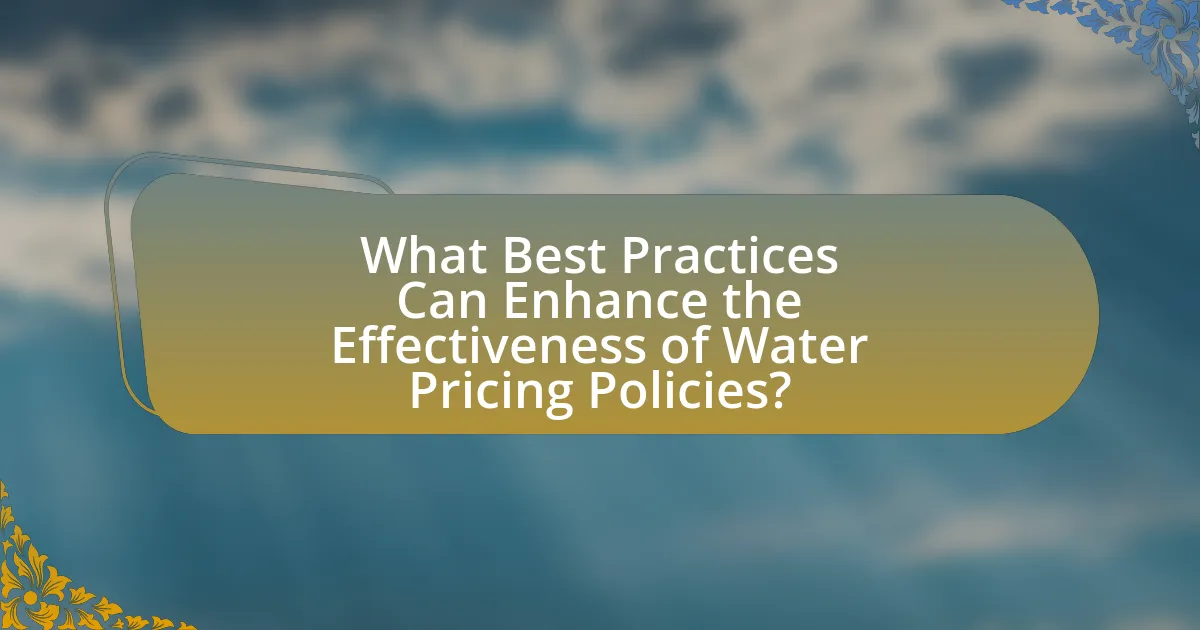
What Best Practices Can Enhance the Effectiveness of Water Pricing Policies?
Best practices that can enhance the effectiveness of water pricing policies include implementing tiered pricing structures, ensuring transparency in pricing mechanisms, and integrating water pricing with conservation incentives. Tiered pricing structures encourage conservation by charging higher rates for excessive use, which has been shown to reduce water consumption significantly; for example, studies indicate that tiered pricing can lead to a 10-30% reduction in water use in urban areas. Transparency in pricing mechanisms builds public trust and encourages compliance, as consumers are more likely to support policies they understand. Additionally, integrating water pricing with conservation incentives, such as rebates for water-efficient appliances, can further motivate consumers to reduce usage, as evidenced by programs that have successfully increased adoption of water-saving technologies.
How can public awareness campaigns support water pricing initiatives?
Public awareness campaigns can significantly support water pricing initiatives by educating the public on the value of water and the necessity of conservation. These campaigns raise awareness about the economic and environmental impacts of water usage, thereby fostering a culture of responsible consumption. For instance, studies have shown that communities exposed to educational campaigns about water scarcity and pricing are more likely to adopt water-saving behaviors, leading to reduced consumption. Additionally, effective campaigns can enhance public acceptance of pricing policies by demonstrating how such measures contribute to sustainable water management and environmental protection.
What strategies can be employed to educate consumers about water conservation?
To educate consumers about water conservation, targeted awareness campaigns can be employed. These campaigns can utilize various media platforms, such as social media, television, and community workshops, to disseminate information on the importance of water conservation and practical methods for reducing water usage. Research indicates that educational programs that include interactive elements, such as demonstrations and hands-on activities, significantly enhance consumer engagement and retention of information. For instance, a study by the American Water Works Association found that communities implementing educational outreach saw a 10-20% reduction in water consumption.
How can stakeholder engagement improve policy acceptance?
Stakeholder engagement can improve policy acceptance by fostering collaboration and building trust among affected parties. When stakeholders, such as community members, businesses, and environmental groups, are actively involved in the policy-making process, they are more likely to feel a sense of ownership and responsibility towards the outcomes. Research indicates that inclusive decision-making leads to higher compliance rates; for instance, a study by the World Bank found that projects with strong stakeholder engagement had a 30% higher success rate in implementation. This engagement allows for diverse perspectives to be considered, which can lead to more effective and equitable policies that address the needs and concerns of all parties involved.
What are the key takeaways for implementing successful water pricing policies?
Successful water pricing policies should incorporate tiered pricing structures, which incentivize conservation by charging higher rates for excessive use. Research indicates that tiered pricing can lead to a reduction in water consumption by 10-30%, as seen in various municipalities that have adopted this model. Additionally, effective communication about the rationale behind pricing changes is crucial; studies show that public understanding of water scarcity and pricing mechanisms enhances compliance and conservation efforts. Lastly, integrating water pricing with broader water management strategies, such as infrastructure investment and public education campaigns, ensures a holistic approach to sustainable water use.
How can policymakers balance economic and environmental goals?
Policymakers can balance economic and environmental goals by implementing integrated water pricing policies that reflect the true cost of water usage while promoting conservation. These policies can incentivize efficient water use, reduce waste, and encourage investments in sustainable technologies. For instance, studies have shown that tiered pricing structures, where the cost of water increases with higher usage, can lead to significant reductions in water consumption and promote conservation efforts. Research from the World Bank indicates that effective water pricing can lead to a 20-30% reduction in water use in urban areas, demonstrating a clear link between economic incentives and environmental sustainability.
What role does technology play in optimizing water pricing strategies?
Technology plays a crucial role in optimizing water pricing strategies by enabling data-driven decision-making and enhancing efficiency in water resource management. Advanced metering infrastructure (AMI) allows for real-time monitoring of water usage, which helps utilities set more accurate pricing based on actual consumption patterns. For instance, a study by the American Water Works Association found that utilities using AMI can reduce operational costs by up to 20%, leading to more sustainable pricing models. Additionally, predictive analytics can forecast demand and identify peak usage times, allowing for dynamic pricing strategies that encourage conservation during high-demand periods. This integration of technology not only improves pricing accuracy but also promotes responsible water use, aligning with conservation efforts.
